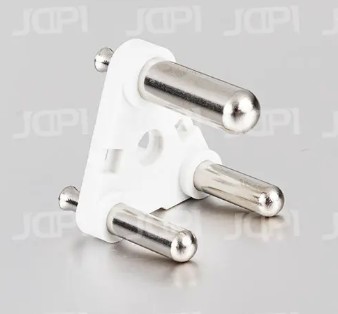The South Africa plug insert is a crucial component of the country's electrical infrastructure, designed to meet specific standards and requirements tailored to its unique electrical system. While it shares the fundamental purpose of providing electrical connectivity with plug inserts from other international standards, such as those used in the United States or Europe, there are distinct differences that set it apart.
One of the most noticeable differences is the plug configuration of the South Africa plug insert. Unlike the two-pin or three-pin configurations commonly found in other countries, the South Africa plug insert features three large round pins arranged in a triangular configuration. The top pin is slightly larger and offset to accommodate polarity, ensuring proper alignment with the corresponding sockets. This distinctive plug design is a defining characteristic of South Africa's electrical standards and is used across the country's electrical infrastructure.
Another key difference lies in the voltage and current rating of the South Africa plug insert. In South Africa, the standard voltage for electrical systems is 230 volts AC, with a frequency of 50 hertz. This voltage level is consistent with other regions that follow the same electrical standards, ensuring compatibility and consistency across electrical devices and appliances. However, it differs from the voltage levels used in other countries, such as the United States, where the standard voltage is 120 volts AC.
Additionally, the South Africa plug insert incorporates a grounding pin, which is essential for grounding electrical appliances and minimizing the risk of electric shock. This grounding pin distinguishes the South Africa plug insert from some international standards, such as the Type A or Type C plugs commonly used in the United States and Europe, which may not include grounding provisions. The presence of a grounding pin reflects South Africa's commitment to electrical safety and adherence to stringent safety standards.
The socket design for South Africa plug inserts also differs from that of other international standards. South Africa sockets typically feature three round-shaped holes arranged in a triangular configuration to match the plug's pin layout. This design ensures a secure and stable connection between the plug insert and the socket, minimizing the risk of disconnection or electrical hazards. In contrast, sockets in other countries may have different configurations to accommodate their respective plug designs, such as two flat-shaped holes for Type A plugs or two round-shaped holes for Type C plugs.
Due to these differences in plug configuration, voltage, current rating, and grounding requirements, the South Africa plug insert is not directly compatible with sockets in other countries and vice versa. Travelers or individuals relocating between countries with different plug standards may require adapters or converters to ensure compatibility and safe operation of electrical devices. Understanding these differences is essential for ensuring safe and reliable electrical connectivity in diverse global environments.



 English
English Deutsch
Deutsch













